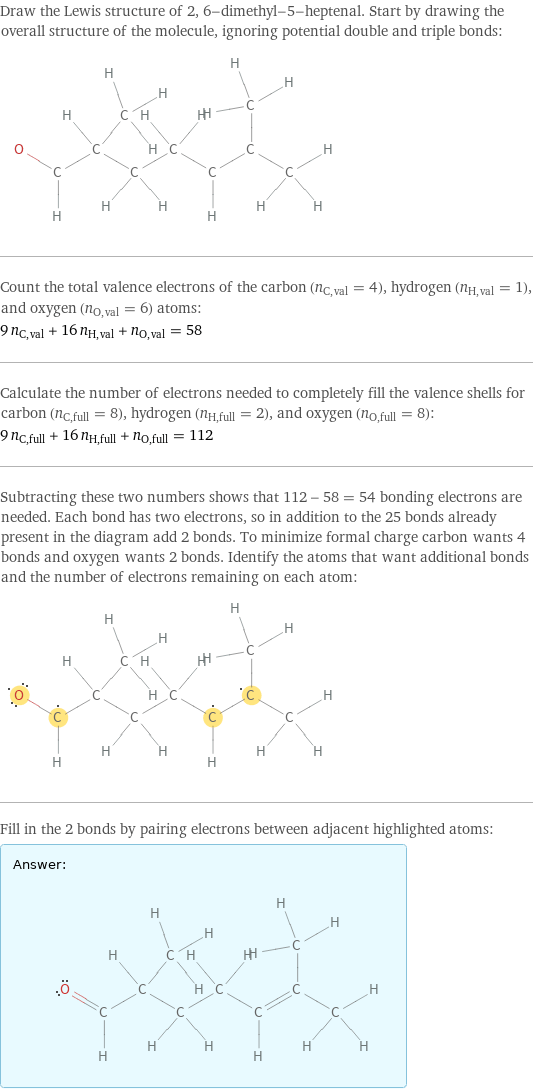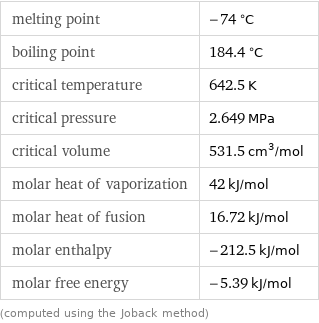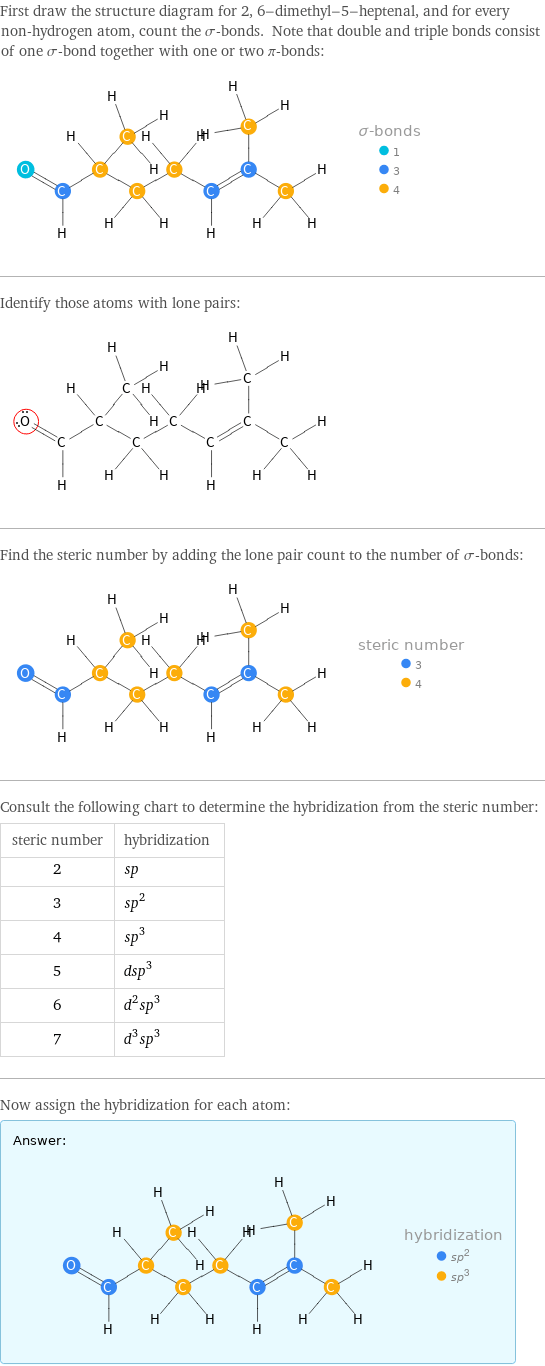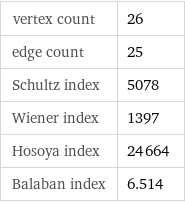Input interpretation

2, 6-dimethyl-5-heptenal
Basic properties

molar mass | 140.2 g/mol formula | C_9H_16O empirical formula | C_9O_H_16 SMILES identifier | CC(=CCCC(C)C=O)C InChI identifier | InChI=1/C9H16O/c1-8(2)5-4-6-9(3)7-10/h5, 7, 9H, 4, 6H2, 1-3H3 InChI key | YGFGZTXGYTUXBA-UHFFFAOYSA-N
Lewis structure

Draw the Lewis structure of 2, 6-dimethyl-5-heptenal. Start by drawing the overall structure of the molecule, ignoring potential double and triple bonds: Count the total valence electrons of the carbon (n_C, val = 4), hydrogen (n_H, val = 1), and oxygen (n_O, val = 6) atoms: 9 n_C, val + 16 n_H, val + n_O, val = 58 Calculate the number of electrons needed to completely fill the valence shells for carbon (n_C, full = 8), hydrogen (n_H, full = 2), and oxygen (n_O, full = 8): 9 n_C, full + 16 n_H, full + n_O, full = 112 Subtracting these two numbers shows that 112 - 58 = 54 bonding electrons are needed. Each bond has two electrons, so in addition to the 25 bonds already present in the diagram add 2 bonds. To minimize formal charge carbon wants 4 bonds and oxygen wants 2 bonds. Identify the atoms that want additional bonds and the number of electrons remaining on each atom: Fill in the 2 bonds by pairing electrons between adjacent highlighted atoms: Answer: | |
Estimated thermodynamic properties

melting point | -74 °C boiling point | 184.4 °C critical temperature | 642.5 K critical pressure | 2.649 MPa critical volume | 531.5 cm^3/mol molar heat of vaporization | 42 kJ/mol molar heat of fusion | 16.72 kJ/mol molar enthalpy | -212.5 kJ/mol molar free energy | -5.39 kJ/mol (computed using the Joback method)
Units

Quantitative molecular descriptors

longest chain length | 8 atoms longest straight chain length | 8 atoms longest aliphatic chain length | 7 atoms aromatic atom count | 0 atoms H-bond acceptor count | 1 atom H-bond donor count | 0 atoms
Elemental composition

Find the elemental composition for 2, 6-dimethyl-5-heptenal in terms of the atom and mass percents: atom percent = N_i/N_atoms × 100% mass percent = (N_im_i)/m × 100% Plan: • Write the chemical formula and gather atomic masses from the periodic table. • Determine values for N_i, m_i, N_atoms and m using these items. • Finally, compute the percents and check the results. Write the chemical formula: C_9H_16O Use the chemical formula to count the number of atoms, N_i, for each element and find the total number of atoms, N_atoms, per molecule: | number of atoms C (carbon) | 9 O (oxygen) | 1 H (hydrogen) | 16 N_atoms = 9 + 1 + 16 = 26 Divide each N_i by N_atoms to calculate atom fractions. Then use the property that atom fractions must sum to one to check the work: | number of atoms | atom fraction C (carbon) | 9 | 9/26 O (oxygen) | 1 | 1/26 H (hydrogen) | 16 | 16/26 Check: 9/26 + 1/26 + 16/26 = 1 Compute atom percents using the atom fractions: | number of atoms | atom percent C (carbon) | 9 | 9/26 × 100% = 34.6% O (oxygen) | 1 | 1/26 × 100% = 3.85% H (hydrogen) | 16 | 16/26 × 100% = 61.5% Look up the atomic mass, m_i, in unified atomic mass units, u, for each element in the periodic table: | number of atoms | atom percent | atomic mass/u C (carbon) | 9 | 34.6% | 12.011 O (oxygen) | 1 | 3.85% | 15.999 H (hydrogen) | 16 | 61.5% | 1.008 Multiply N_i by m_i to compute the mass for each element. Then sum those values to compute the molecular mass, m: | number of atoms | atom percent | atomic mass/u | mass/u C (carbon) | 9 | 34.6% | 12.011 | 9 × 12.011 = 108.099 O (oxygen) | 1 | 3.85% | 15.999 | 1 × 15.999 = 15.999 H (hydrogen) | 16 | 61.5% | 1.008 | 16 × 1.008 = 16.128 m = 108.099 u + 15.999 u + 16.128 u = 140.226 u Divide the mass for each element by m to calculate mass fractions. Then use the property that mass fractions must sum to one to check the work: | number of atoms | atom percent | mass fraction C (carbon) | 9 | 34.6% | 108.099/140.226 O (oxygen) | 1 | 3.85% | 15.999/140.226 H (hydrogen) | 16 | 61.5% | 16.128/140.226 Check: 108.099/140.226 + 15.999/140.226 + 16.128/140.226 = 1 Compute mass percents using the mass fractions: Answer: | | | number of atoms | atom percent | mass percent C (carbon) | 9 | 34.6% | 108.099/140.226 × 100% = 77.09% O (oxygen) | 1 | 3.85% | 15.999/140.226 × 100% = 11.41% H (hydrogen) | 16 | 61.5% | 16.128/140.226 × 100% = 11.50%
Elemental oxidation states

The first step in finding the oxidation states (or oxidation numbers) in 2, 6-dimethyl-5-heptenal is to draw the structure diagram. Next set every oxidation number equal to the atom's formal charge: In 2, 6-dimethyl-5-heptenal hydrogen is not bonded to a metal with lower electronegativity, so it will have an oxidation state of +1. Any element bonded to hydrogen gains the bonding electrons, decreasing their oxidation state by 1 for every bond: With hydrogen out of the way, look at the remaining bonds. There are 1 carbon-oxygen bond, and 8 carbon-carbon bonds. For each of these bonds, assign the bonding electrons to the most electronegative element. First examine the carbon-oxygen bond: element | electronegativity (Pauling scale) | C | 2.55 | O | 3.44 | | | Since oxygen is more electronegative than carbon, the electrons in this bond will go to oxygen. Decrease the oxidation number for oxygen (by 1 for single bonds, 2 for double bonds, and 3 for triple bonds), and increase the oxidation number for carbon accordingly: Next look at the carbon-carbon bonds: element | electronegativity (Pauling scale) | C | 2.55 | C | 2.55 | | | Since these elements are the same the bonding electrons are shared equally, and there is no change to the oxidation states: Now summarize the results: Answer: | | oxidation state | element | count -3 | C (carbon) | 3 -2 | C (carbon) | 2 | O (oxygen) | 1 -1 | C (carbon) | 2 0 | C (carbon) | 1 +1 | C (carbon) | 1 | H (hydrogen) | 16
Orbital hybridization

First draw the structure diagram for 2, 6-dimethyl-5-heptenal, and for every non-hydrogen atom, count the σ-bonds. Note that double and triple bonds consist of one σ-bond together with one or two π-bonds: Identify those atoms with lone pairs: Find the steric number by adding the lone pair count to the number of σ-bonds: Consult the following chart to determine the hybridization from the steric number: steric number | hybridization 2 | sp 3 | sp^2 4 | sp^3 5 | dsp^3 6 | d^2sp^3 7 | d^3sp^3 Now assign the hybridization for each atom: Answer: | |
Topological indices

vertex count | 26 edge count | 25 Schultz index | 5078 Wiener index | 1397 Hosoya index | 24664 Balaban index | 6.514